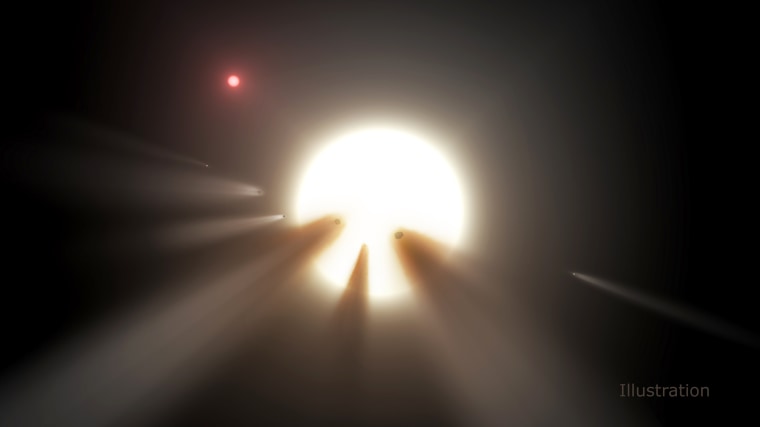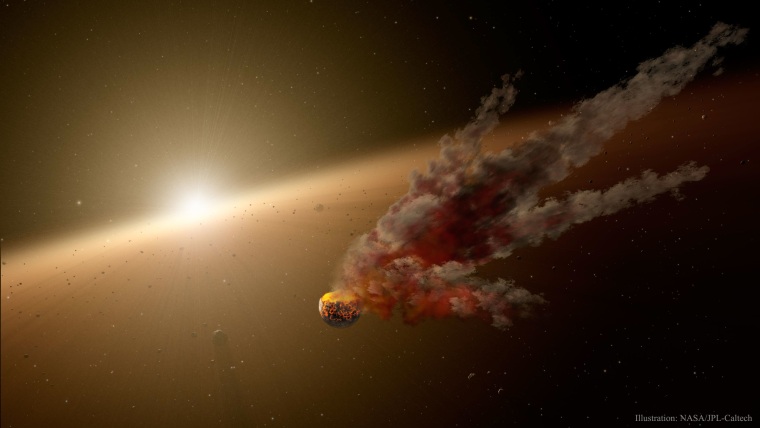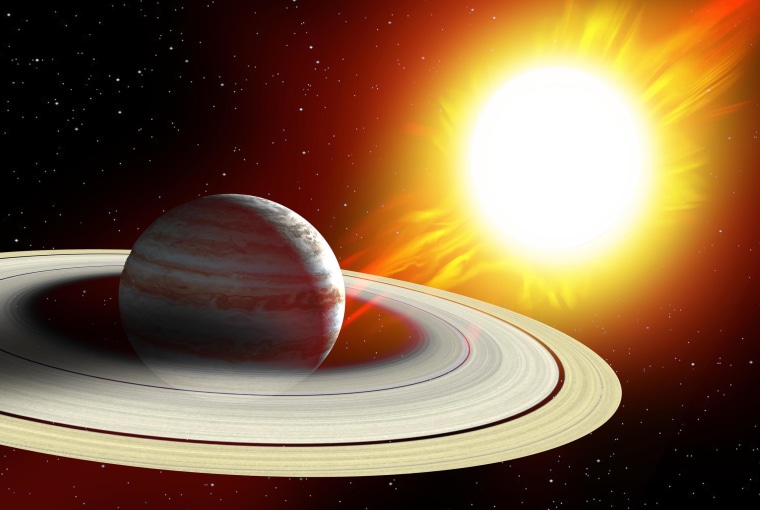It’s a mystery worthy of John Grisham: What’s causing the erratic behavior of KIC 8462852, better known as Tabby’s Star?
In case you’ve been comatose for the past two years, this remarkable star — a bit larger than the sun and 1,300 light-years away — has been a science celebrity. Unlike any other known star, it’s been seen to dim occasionally by as much as 22 percent, and for days at a time. The reduction in light doesn’t seem to recur on a regular basis, as would be the case if a planet were passing in front of (transiting) it and blocking some of its light. And the dimming is much greater than even the heftiest of planets could cause.
If it’s not a transiting planet, what sort of celestial sunshade could account for the intermittent dips in this star’s shine?
Astronomers, endlessly inventive, have proffered a lineup of possible explanations. These include detritus from comets, the leftovers of destroyed planets, or — most beguiling of all — an immense orbiting structure built by industrious aliens. But this week astronomers at the Universidad de Antioquia, in Colombia, presented new research suggesting that a ringed planet, orbiting close to Tabby’s Star, might be the cause of this enigmatic behavior.

A ring system can cover up a lot more of a star’s disk than a planet can, just as a hat brim shades more of your noggin than a skullcap. Saturn’s ring system, for example, has a diameter that’s two-and-a-half times greater than the planet itself. Imagine if Saturn’s orbit were much closer to the sun and that its ring system were tilted on its side as viewed from Earth. It would be the mother of all sunshades. And from far, far away, you might never see Saturn — you’d only notice that the light from our sun dipped periodically as Saturn pirouetted around it.
So maybe Tabby’s Star has as a close companion a tilted, massively ringed planet — one that’s too small to be seen from 1,300 light-years but big enough to block out a substantial fraction of the star’s disk.
But how do we explain the fact that the amount of dimming seems to vary? Last May, Tabby’s Star dimmed again, but only by less than 2 percent. Clearly, what’s called for is a variable sunshade, not the regular darkening of a planet.
No problem, say the Colombian astronomers. If the hypothetical ringed planet orbits close to Tabby’s Star, gravitational interactions would flap the ring up and down, thus varying the amount of shading. It’s a bit like bending the brim of your hat one way and then another.
This is a pretty neat scenario, even if aliens have been written out of the script. But like all the other proposed explanations for this weird cosmic wonder, there are problems. To begin with, the ring system would have to be very, very big to block as much as one-fifth of Tabby’s starlight. Indeed, to shade that amount would require a ring system roughly three times the diameter of Saturn’s.

Even if the planet’s ring is endlessly flip-flopping, careful measurements should show periodic (rather than random) dips in stellar brightness. And since a close-in planet would complete its orbit in months rather than decades, the dips should come often enough to make them easy to notice. But though observations continue, no regularly spaced darkening has yet been seen.
Here’s another serious problem: the gravitational tugs that would cause a large ring system to bob up and down would also quickly pull the ring apart. Jack Lissauer, a space scientist at NASA’s Ames Research Center in Mountain View, Calif., calculates that the rings envisioned by the Colombian researchers would dissipate in less than a century. That’s not even an eye-blink in the life history of a star, so encountering the strange behavior of Tabby’s Star just when we turned our telescopes in its direction is a bit like observing a child just as he says his first word.
The bottom line? The mystery remains. More observations of Tabby’s Star are needed, but more than likely we’ll need to discover other objects with similarly gonzo behavior. Could a super-Saturn be the culprit? Perhaps, but it’s premature to claim that this new explanation has the ring of truth.
FOLLOW NBC MACH ON TWITTER, FACEBOOK, AND INSTAGRAM.
Illustration at top of page courtesy Ron Miller/Black Cat Studios.

